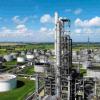Dear Everyone,
I am trying to model Ammonia Heat Pump in HYSYS with condensing temperature at 56 C & evaporation temperature as 2 C. This was the method I followed in HYSYS.
- Defined a Ammonia stream at 2 C & vapor fraction 1 and sent it to compressor.
- Compressor outlet temperature was provided at 56 C.
- Pressure at Compressor outlet was calculated by 8.2 bar whereas based on literature it should have been 24 bara
- If I remove the efficiency from default values and try to input 24 bara & 56 C, then it shows negative efficiency.
- I am connecting compressor outlet to Condensor inlet. I understand that in Condensor of heat pump, there is no temperature change & pressure change. Only phase changes. However, when I try to make DP = 0 & DT = 0 across Condensor, it gives me 0 heat duty. If I try to manually input heat duty and DT=0, it gives me unrealistic pressure drop.
Please help on how to properly model compressor, condensor, JT valve in HYSYS.

 FB
FB














